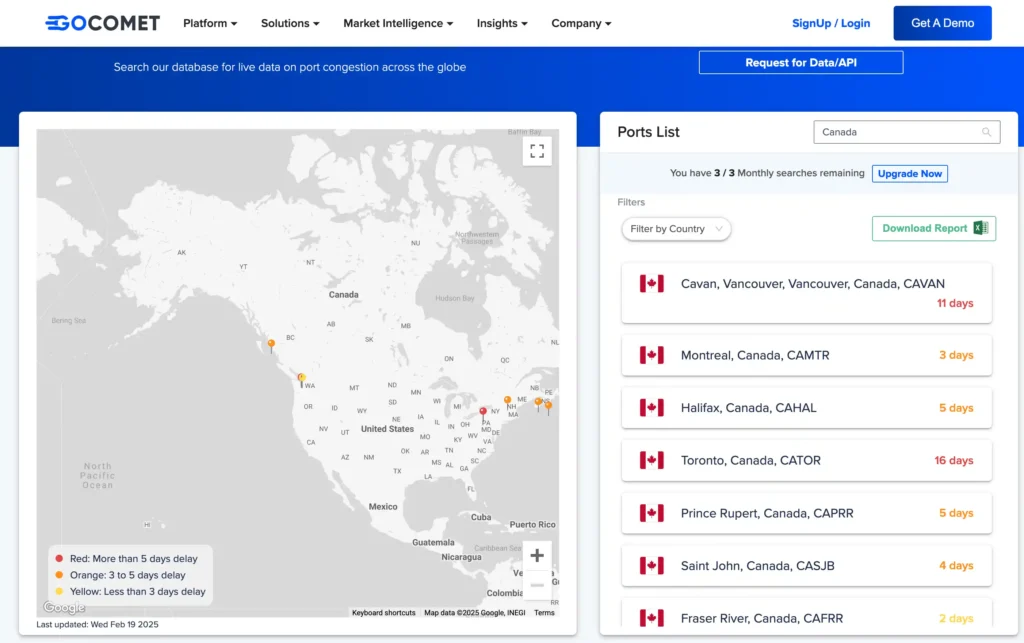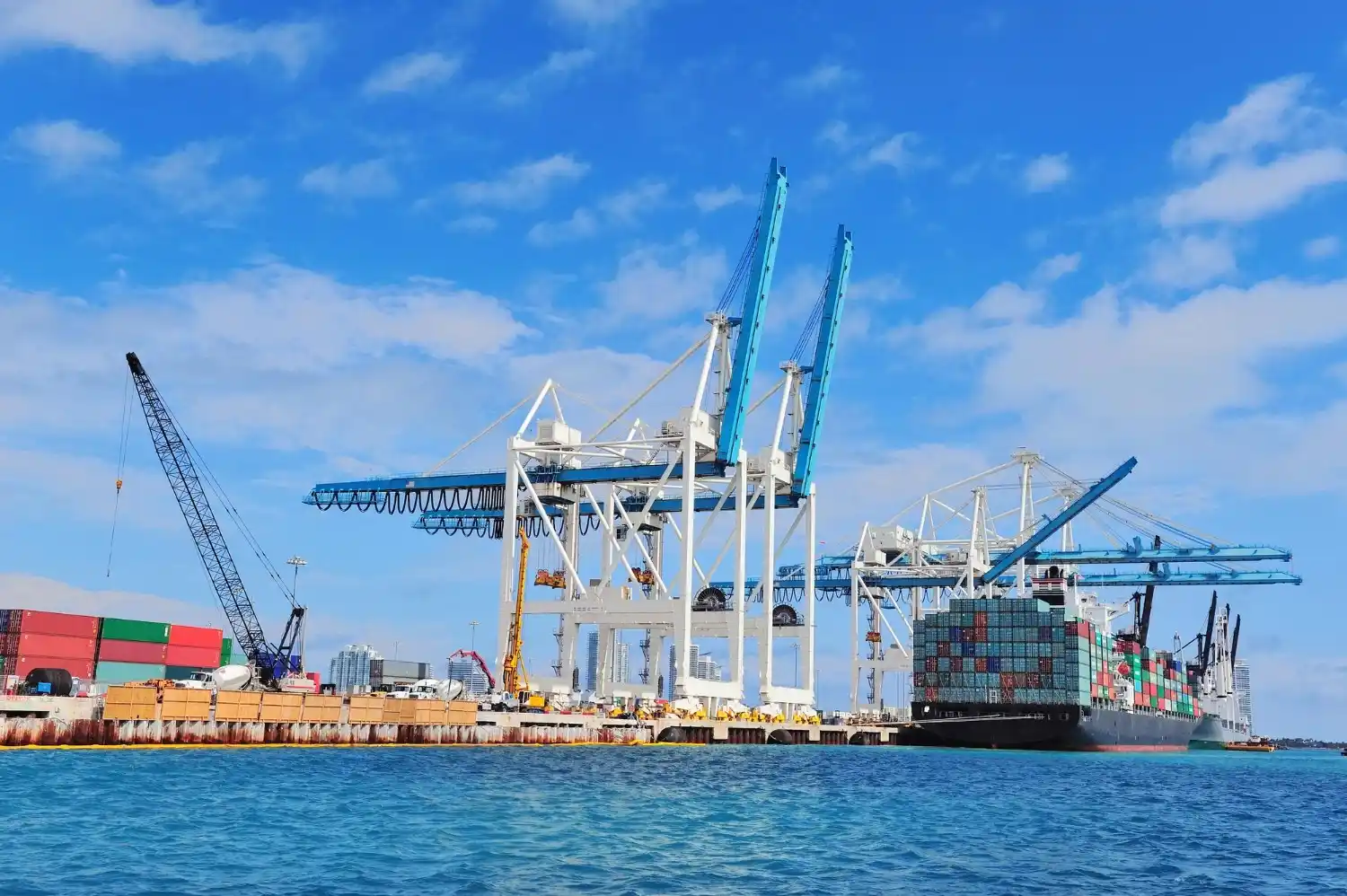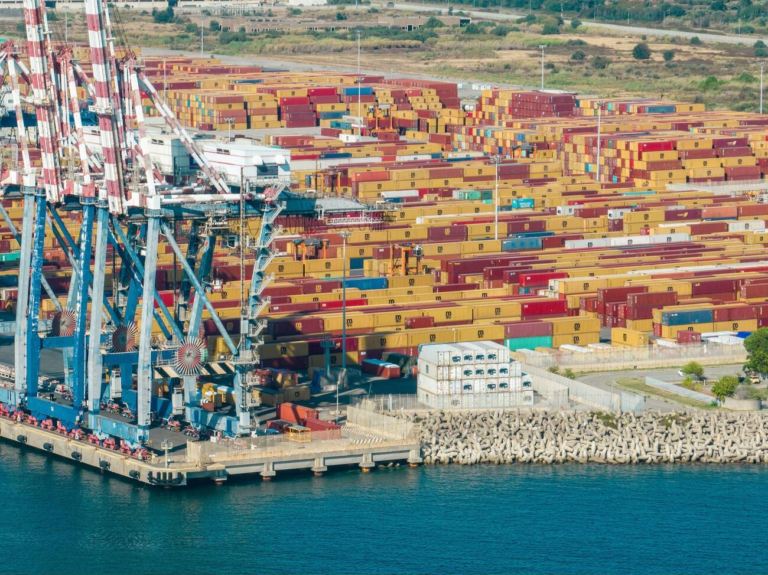Navigating Shipping Costs from China to Canada: A Complete Guide
Table of Contents
Shipping costs from China to Canada can make or break your business margins. Get them wrong, and you’re stuck with high expenses and delays. Get them right, and you stay competitive while keeping supply chains smooth.
Understanding freight options, taxes, and transit times is key to importing electronics, furniture, or raw materials. How much should you expect to pay? What’s the cheapest way to ship? This guide breaks it all down; fast, clear, and with no fluff.
Shipping Costs from China to Canada
Shipping costs from China to Canada depend on several factors, including freight mode, cargo weight, dimensions, delivery speed, and seasonal demand. Businesses must consider both cost and transit time when selecting the right shipping method.
Sea and Ocean Freight Rate Index
Sea freight is the most economical option for bulk shipments and heavy cargo, but transit times are longer. Rates fluctuate due to global demand, fuel prices, container shortages, and port congestion.
Estimated Sea Freight Costs and Transit Time
| Shipping Mode | Estimated Cost | Transit Time |
| Full Container Load (FCL) | $2,500 – $6,000 per 40ft container | 20–40 days |
| Less than Container Load (LCL) | $200 – $400 per cubic meter | 25–45 days |
Air Freight and Express Shipping Costs
Air freight is the best choice for time-sensitive and high-value goods. While more expensive than sea freight, it significantly reduces delivery time. Express services from carriers like DHL, FedEx, and UPS provide even faster door-to-door delivery.
Estimated Air Freight Costs and Transit Time
| Shipping Mode | Estimated Cost | Transit Time |
| Standard Air Freight | $5 – $12 per kg | 5–10 days |
| Express Shipping (DHL, FedEx, UPS) | $6 – $15 per kg | 2–5 days |
Key Factors Affecting Shipping Costs from China to Canada
Several factors impact shipping costs, making it essential for businesses to monitor changes:
- Fuel Prices: Fluctuations in oil prices directly affect freight rates, with surcharges applied by carriers.
- Customs Duties & Tariffs: Import duties depend on product classification under the Canadian Customs Tariff Schedule. Some goods may qualify for lower tariffs under trade agreements.
- Peak Seasons: Costs surge during peak periods, such as the Chinese New Year, Golden Week, and the holiday season. Booking shipments in advance can help mitigate price increases.
- Port Congestion & Shipping Routes: High cargo volumes at ports like Vancouver, Toronto, and Montreal can lead to longer processing times and higher costs.
- Freight Market Demand: Rates fluctuate based on supply chain disruptions, global trade policies, and container availability.
Monitoring these factors and working with reliable freight partners can help businesses secure cost-effective shipping options and minimize delays.
Main Shipping Methods from China to Canada
Choosing the right shipping method is crucial for businesses that want to balance cost-effectiveness, delivery speed, and product safety when shipping from China to Canada. There are three primary shipping options businesses usually rely on: air freight, ocean freight, and express shipping. Understanding the advantages and drawbacks of each can help you select the most appropriate method for your needs.
Air Freight from China to Canada
Air freight offers the fastest way to move goods internationally, making it the best choice when time is critical. Typically, air shipments take between 3 to 10 days, depending on the route and flight schedules. This is ideal for high-value or time-sensitive products, such as electronics, pharmaceuticals, and luxury goods.
Advantages of Air Freight:
- Speed: It’s the fastest method, with delivery times ranging from 3 to 10 days. Ideal for businesses with urgent delivery needs.
- Reliability: Airlines maintain a strict schedule, making it one of the most predictable shipping options.
- Security: Air freight is generally safer and less likely to experience theft or damage compared to other methods.
However, air freight tends to be more expensive than ocean freight due to higher operational costs and fuel charges. It’s best suited for smaller, higher-value shipments where quick delivery justifies the cost.
Ocean Freight from China to Canada
For larger shipments or when costs need to be minimized, ocean freight is the preferred method. While transit times for ocean freight can range from 14 to 37 days, it is significantly cheaper per kilogram than air freight.
Ocean freight is ideal for businesses dealing with large quantities of goods, such as manufacturers, wholesalers, and retailers. You can ship everything from raw materials to finished products, and the shipping options (like Full Container Load (FCL) or Less-than-Container Load (LCL)) offer flexibility depending on shipment size.
Advantages of Ocean Freight:
- Cost-Effective: Shipping large volumes of goods by sea offers the lowest cost per unit of all shipping methods.
- Large Cargo Capacity: Ocean vessels can carry vast amounts of cargo, including bulky items like machinery, furniture, and industrial products.
- Less Impacted by Fuel Prices: While fuel prices can impact shipping costs, ocean freight rates remain more stable compared to air freight.
However, ocean freight is slower, and the longer transit times mean that shipments should not be time-sensitive.
Key Ports in China and Canada
Selecting the right port for your shipment can significantly impact delivery speed and cost efficiency. Ports serve as the starting and ending points for sea and air freight, and the location of your goods in China and Canada will influence costs, transit times, and logistical planning.
Top Ports in China:
- Shanghai Port: As one of the busiest ports in the world, Shanghai offers excellent connectivity to major Canadian ports and is ideal for shipping bulk goods.
- Shenzhen Port: Best known for its electronics exports, Shenzhen is another key port with robust connections to Canada, especially for consumer goods.
- Ningbo Port: Ningbo is ideal for businesses shipping containers, raw materials, and automotive parts to Canada.
Top Ports in Canada:
- Port of Vancouver: Canada’s busiest port, Vancouver is ideal for businesses looking to ship to the West Coast of Canada. It has a well-established infrastructure and quick access to major Asian trade routes.
- Port of Montreal: Montreal serves as the key Eastern Canada gateway and is well-connected to the rest of Canada via the St. Lawrence Seaway.
- Port of Toronto: Positioned centrally, Toronto is another key port for shipments arriving from China, especially for businesses focused on Ontario and surrounding regions.
Understanding Port Selection for Cost Efficiency
Port selection plays a major role in managing shipping costs. Choosing a port closer to your business or end customers can reduce last-mile delivery expenses. For example, shipping to Vancouver might be cheaper for businesses on the West Coast, while Montreal may be more convenient for shipments to Eastern Canada.
Port congestion and traffic levels also affect costs. Higher-traffic ports often have lower shipping rates due to competition among carriers and more frequent sailings. They also tend to have well-established logistics networks, making inventory management, customs clearance, and delivery more efficient.

To avoid unexpected delays, businesses can use tools like the Live Worldwide Port Congestion Database to track real-time congestion levels at major ports. This helps in selecting ports that offer both cost savings and faster processing times.
Express Shipping
For those needing fast delivery without the long wait times of air freight, express shipping services offer an attractive option. Express couriers like DHL, FedEx, and UPS can deliver goods within 2 to 7 days from China to Canada.
Express shipping typically includes door-to-door delivery, where the courier handles everything from pick-up to final delivery. This method is ideal for smaller, urgent shipments, such as documents, samples, or high-demand consumer products.
Advantages of Express Shipping:
- Speed: Express shipping is the fastest way to get your products from China to Canada.
- Door-to-Door Service: No need for customs brokerage or dealing with multiple logistics providers.
- Ideal for Smaller Shipments: Express services work best for time-sensitive, high-value, or small-scale shipments.
Although more expensive, express shipping is worth the cost when urgency is the highest priority.
Air Freight vs. Ocean Freight: Which Is Right for Your Shipment?
When shipping goods from China to Canada, the choice between air freight and ocean freight largely depends on your business goals and shipment needs. Below is a comparison of both options to help you make a more informed decision.
Air Freight vs. Ocean Freight Comparison
| Criteria | Air Freight | Ocean Freight |
| Speed | Fastest option, delivery in 3 to 10 days | Slower transit times, 14 to 37 days |
| Cost | Expensive, especially for large shipments | More cost-effective, especially for bulk |
| Capacity | Ideal for small, high-value shipments | Suited for large and bulky shipments |
| Reliability | Very reliable with minimal delays | Can be affected by weather and port congestion |
| Ideal Shipment Type | Time-sensitive, perishable goods, electronics | Large, non-urgent shipments like raw materials or furniture |
| Environmental Impact | Higher carbon emissions per unit of weight | Lower carbon emissions for large volumes |
Air Freight
Air freight is the fastest option, often used for urgent shipments or high-value goods. It ensures a quick transit time, which is crucial for industries like pharmaceuticals, electronics, or fashion, where delays could result in lost revenue or missed market opportunities.
- Advantages: Air freight is best when speed is critical. The security of the goods is another key benefit, as air shipments are typically less prone to damage or theft. Furthermore, for smaller shipments, air freight can be more economical than shipping large volumes via ocean freight.
- Disadvantages: The cost of air freight is the primary drawback, especially for larger loads. It also has a larger carbon footprint, which may be a concern for businesses with sustainability goals.
Ocean Freight
Ocean freight is the most cost-effective method for shipping large volumes of goods. For bulk shipments that are not time-sensitive, ocean freight can provide substantial savings.
- Advantages: Ocean freight offers the lowest cost for transporting large shipments, especially when using Full Container Load (FCL) options. It’s suitable for industries with large quantities of manufactured goods, raw materials, or equipment.
- Disadvantages: The biggest disadvantage is the longer transit times, which may not be ideal for urgent shipments. Port congestion and weather delays can also impact delivery times.
Example of Duty Calculation
When importing goods from China to Canada, customs duties and taxes can impact the total cost of the shipment. Duties are generally calculated based on the value of the goods, their classification, and their origin. Below is an example of how duty and taxes are calculated for a shipment.
| Item Description | Value of Goods (USD) | Duty Rate | Customs Duty (USD) | Goods and Services Tax (GST) (5%) | Total Cost (USD) |
| 1. Electronics (Laptop) | 1,000 | 5% | 50 | 52.50 | 1,102.50 |
| 2. Clothing (T-shirts) | 500 | 18% | 90 | 29.50 | 619.50 |
| 3. Furniture (Sofa Set) | 2,500 | 10% | 250 | 137.50 | 2,887.50 |
- Duty Rate: The percentage applied to the value of the goods to calculate the duty.
- Customs Duty: The amount of money to be paid to customs based on the duty rate.
- GST: The Goods and Services Tax (5%) applied to the total value, including duty.
In this example, electronics (laptop) attract a 5% duty, while clothing is subject to a higher 18% duty rate. Furniture, a bulky item, is subject to a 10% duty rate.
Key Factors Influencing Import Taxes and Duties
Import taxes and duties can significantly impact shipping costs when sending goods from China to Canada. Understanding the factors that affect these costs helps businesses plan better. Key factors include:
1. HS Code (Harmonized System Code)
Each product has a unique HS code that determines the applicable duty rate. Some goods may qualify for reduced duties if they meet certain trade agreement criteria.
2. Product Value
Customs assess the value of goods based on the invoice price, including shipping and insurance. Higher-value items tend to attract higher duties.
3. Type of Goods
Duty rates vary by product category. For example, electronics often have lower duties, while luxury goods may have higher rates.
4. Origin of Goods
Goods from countries with free trade agreements (FTAs) may qualify for reduced duties. Products from China may have different tariffs compared to FTA countries.
5. Shipping Method
Air freight clears customs faster than ocean freight, but the method influences how duties are calculated, considering the full shipment cost.
6. Importer’s Customs Status
Companies with customs bonds or authorized importer status may qualify for reduced duties, as well as businesses in certain sectors, like manufacturing.
Tools to Simplify Duty Calculations
To help businesses navigate the complexities of customs duty calculations, there are several online tools and customs calculators available. These tools allow you to input the HS code (Harmonized System code) of your product to determine the exact duty rate and estimate taxes based on the value of the goods. Some popular platforms include:
- Canada Border Services Agency (CBSA): Provides official duty rates and tariff information.
- HS Code Finder: Helps identify the appropriate code for your product, which influences the duty rate.
- DutyCalculator.com: An online tool that can help calculate duties and taxes for international shipments.
By understanding how duties are calculated and using available tools, businesses can better estimate their landed costs and make informed decisions on which shipping method works best for their needs.
Express Shipping from China to Canada
Express shipping is an excellent option for businesses needing quick and reliable delivery. Unlike standard shipping methods, express services prioritize speed, security, and efficiency. This method is particularly beneficial for time-sensitive shipments such as samples, documents, or small orders that must reach the destination quickly.
Here are some key benefits of express shipping:
- Faster Transit Times: Express shipping ensures the fastest possible delivery, typically taking 3-7 days for shipments from China to Canada, depending on the destination.
- Reliable Tracking: You get real-time updates on the shipment’s progress, ensuring transparency and peace of mind throughout the shipping process.
- Customs Handling: Express carriers generally take care of customs clearance on your behalf, reducing the chances of delays or issues at customs.
- Cost: While express shipping is more expensive than standard freight options, it can be worth the investment for urgent shipments. The cost varies based on weight, dimensions, and delivery speed.
Express shipping is often the go-to solution for businesses that require quick delivery without compromising on service quality. However, it’s essential to assess your shipping needs and ensure that express shipping is the most suitable option for your business goals.
Shipping Cost Calculator: Picking the Best Method
Choosing the most cost-effective shipping method from China to Canada can be challenging, especially when there are multiple options available, each with its own set of costs and transit times. A shipping cost calculator is an invaluable tool for businesses to simplify this process.
Here’s how it can help you make the best decision:
- Compare Different Methods: Whether you’re deciding between air freight, ocean freight, or express shipping, a shipping calculator allows you to input specific details (like weight, dimensions, and destination) to see which method offers the best balance of cost and delivery speed.
- Accurate Estimates: Shipping calculators provide real-time cost estimates, helping you avoid unexpected costs or delays. This is especially useful for international shipments where customs fees and other charges can vary.
- Time-Saving: By quickly comparing all available shipping methods, a shipping calculator saves businesses time when planning their logistics strategy.
- Tailored to Business Needs: Many shipping calculators are tailored to businesses that frequently ship large volumes, offering additional features like bulk discounts or integrated tracking for easier management of shipments.
Using a shipping cost calculator ensures that your business makes an informed decision, saving money while ensuring timely delivery. It’s a smart way to assess and select the right method for each shipment, depending on your budget and urgency.
Conclusion
Understanding shipping costs from China to Canada is essential for making informed decisions. Whether opting for air or ocean freight, the right choice depends on your shipment’s size, urgency, and budget. Key factors like fuel prices, cargo volume, and port selection influence the overall cost.
By considering import taxes, duties, and using duty calculators, businesses can simplify the process. Balancing cost, transit time, and shipment type will help ensure efficient, cost-effective imports from China to Canada.
FAQs
1. How long does sea freight take from China to Canada?
Sea freight transit times vary based on the specific ports of departure and arrival. Generally, shipping from China to Canada takes between 14 to 37 days.
2. How much does a container from China to Canada cost?
The cost of shipping a full container load (FCL) from China to Canada fluctuates based on factors like container size, shipping route, and current market conditions. As of recent data, rates can range from approximately $5,086.80 to $7,473.20 per 40-foot container.
3. How much does less than full container load (LCL) shipping from China to Canada cost?
LCL shipping is suitable for smaller shipments that don’t require a full container. Costs are typically calculated per cubic meter, with rates varying based on the shipping route and current demand. For instance, LCL rates from Shanghai to Vancouver range from $150.72 to $175.84 per cubic meter.
4. What are the main shipping methods from China to Canada?
The primary shipping methods include:
- Sea Freight: Cost-effective for large shipments with longer transit times.
- Air Freight: Faster delivery for urgent or high-value goods, typically taking 3–10 days.
- Express Shipping: Fastest option with door-to-door service, ideal for small, time-sensitive shipments.
5. What factors influence shipping costs from China to Canada?
Several factors affect shipping costs, including:
- Fuel Prices: Fluctuations can impact overall shipping rates.
- Shipping Route: Popular routes may offer more competitive pricing.
- Cargo Volume and Size: Larger shipments often benefit from volume discounts.
- Customs Duties and Taxes: Import fees imposed by Canadian authorities.
- Seasonal Demand: Peak seasons can lead to higher prices and limited availability.
6. Are there any restrictions on importing goods from China to Canada?
Yes, certain goods may have import restrictions or require special permits. It’s essential to consult the Canada Border Services Agency (CBSA) and other relevant authorities to ensure compliance with Canadian import regulations.
7. How can I calculate import duties and taxes for goods shipped from China to Canada?
Import duties and taxes are calculated based on the type of goods, their value, and the applicable tariff rates. Utilizing tools like the CBSA’s duty calculator can provide accurate estimates.
8. What documentation is required for shipping goods from China to Canada?
Essential documents include:
- Commercial Invoice: Details of the transaction between buyer and seller.
- Bill of Lading or Airway Bill: Contract between the shipper and carrier.
- Packing List: Itemized list of shipped goods.
- Certificate of Origin: Indicates the origin country of the goods.
- Import Permits (if applicable): Required for certain regulated goods.
9. Should I work with a freight forwarder for shipping from China to Canada?
Partnering with a reputable freight forwarder can streamline the shipping process, handle complex logistics, and ensure compliance with international shipping regulations, making the process more efficient and less stressful.
10. How can I track my shipment from China to Canada?
Most carriers and freight forwarders offer online tracking systems. By entering your shipment’s tracking number on the carrier’s website, you can monitor its progress in real-time.






